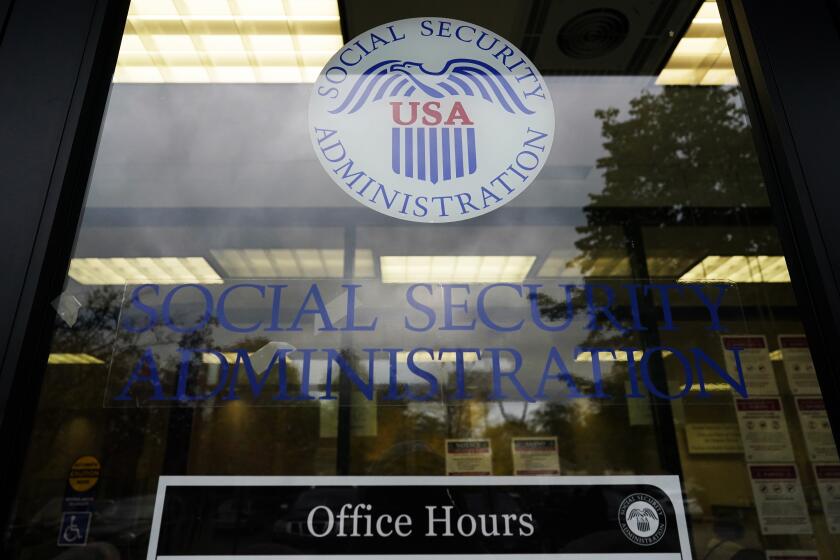Iran, U.S. envoys meet face to face in initial round of nuclear talks

- Share via
MUSCAT, Oman — Iran and the United States will hold more negotiations next week over Tehran’s rapidly advancing nuclear program, Iranian state television reported Saturday at the end of the first round of talks between the two countries since President Trump returned to the White House.
Iran’s state-run broadcaster reported that U.S. Mideast envoy Steve Witkoff and Iranian Foreign Minister Abbas Araghchi “briefly spoke” together — the first time the two nations have done that since the Obama administration.
Tehran’s declaration that the two sides spoke face to face — even if briefly — suggests the negotiations went well even to Iranian state TV, which long has been controlled by hard-liners.
In a statement released Saturday afternoon, the White House described the discussions as “very positive and constructive,” while conceding that the issues at hand “are very complicated.”
“Special Envoy Witkoff’s direct communication today was a step forward in achieving a mutually beneficial outcome,” the White House said.
The next round of talks will take place next Saturday, according to the Iranian and U.S. statements.
The first round of talks began around 3:30 p.m. Iranian time. The two sides spoke for more than two hours on the outskirts of the Omani capital, Muscat, ending around 5:50 p.m. A convoy believed to be carrying Witkoff returned to Muscat before disappearing into traffic around a neighborhood that is home to the U.S. Embassy.
The stakes of the negotiations are high for both nations. Trump repeatedly has threatened to unleash airstrikes targeting Iran’s nuclear program if a deal isn’t reached. Iranian officials increasingly warn that they could pursue a nuclear weapon with their stockpile of uranium enriched to near-weapons-grade levels.
‘This is just the beginning’
Associated Press journalists saw a convoy believed to be carrying Witkoff leave the Omani Foreign Ministry on Saturday afternoon and then speed off toward the outskirts of Muscat. The convoy went into a compound, and a few minutes later, Iranian Foreign Ministry spokesman Esmail Baghaei wrote on the social platform X that the “indirect talks” had begun.
Afterward, Araghchi described the meeting to Iranian state TV as constructive, with four rounds of messages exchanged during the indirect portion.
“Neither we nor the other side are interested in fruitless negotiations — so-called ‘talks for the sake of talks,’ wasting time, or drawn-out, exhausting negotiations,” he said. “Both sides, including the Americans, have said that their goal is also to reach an agreement in the shortest possible time. However, that will certainly not be an easy task.”
That the two men spoke face to face satisfied a U.S. demand. Trump and Witkoff both had described the talks in advance as being “direct.”
“I think our position begins with dismantlement of your program. That is our position today,” Witkoff told the Wall Street Journal before his trip. “That doesn’t mean, by the way, that at the margin we’re not going to find other ways to find compromise between the two countries.”
He added: “Where our red line will be, there can’t be weaponization of your nuclear capability.”
Araghchi, however, sought to downplay the encounter as “a brief initial conversation, greetings and polite exchanges” — probably to avoid drawing the anger of hard-liners in Iran.
Sayyid Badr Albusaidi, Oman’s foreign minister who shuttled between the two sides, said the countries have a “shared aim of concluding a fair and binding agreement.”
“I would like to thank my two colleagues for this engagement, which took place in a friendly atmosphere conducive to bridging viewpoints and ultimately achieving regional and global peace, security and stability,” Albusaidi wrote on X. “We will continue to work together and put further efforts to assist in arriving at this goal.”
Sanctions relief and enrichment remain top issues
While the U.S. side can offer sanctions relief for Iran’s beleaguered economy, it remains unclear just how much Iran will be willing to concede. Under the 2015 nuclear deal, Iran could maintain only a small stockpile of uranium enriched to 3.67%. Today, Tehran’s stockpile could allow it to build multiple nuclear weapons if it chooses, and it has some material enriched up to 60%, a short, technical step away from weapons-grade levels. Judging from negotiations since Trump unilaterally withdrew the United States from the deal in 2018, Iran will probably ask to keep enriching uranium up to at least 20%.
One thing it won’t do is give up its program entirely. That makes the proposal of Israeli Prime Minister Benjamin Netanyahu of a so-called Libyan solution — “you go in, blow up the facilities, dismantle all the equipment, under American supervision, American execution” — unworkable.
Iranians including Supreme Leader Ayatollah Ali Khamenei have held up the example of late Libyan leader Moammar Gadafi — killed with his own gun by rebels in the country’s 2011 Arab Spring uprising — as a warning about what can happen when you trust the United States.
Gambrell writes for the Associated Press. AP writer Amir Vahdat in Tehran contributed to this report.
More to Read
Sign up for Essential California
The most important California stories and recommendations in your inbox every morning.
You may occasionally receive promotional content from the Los Angeles Times.










